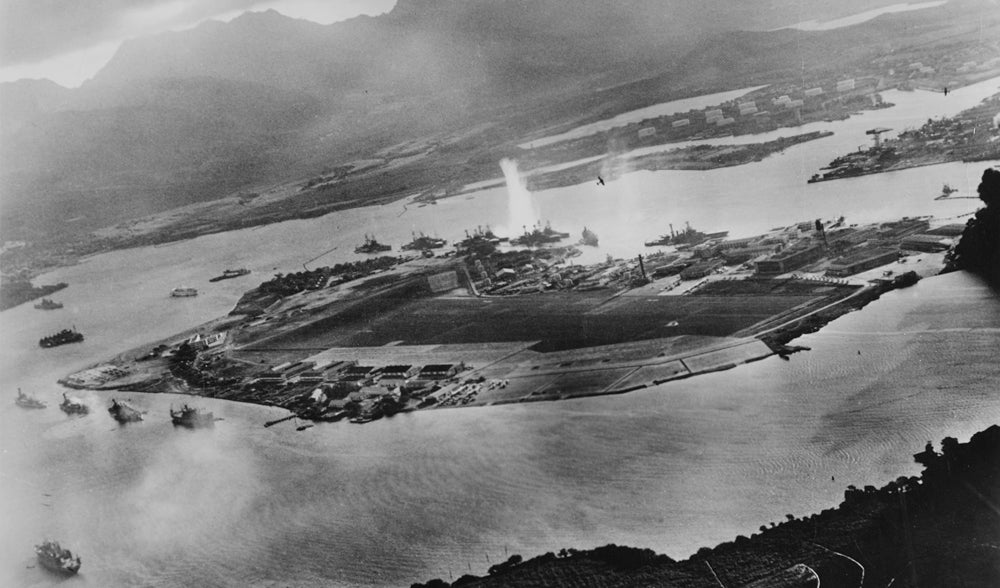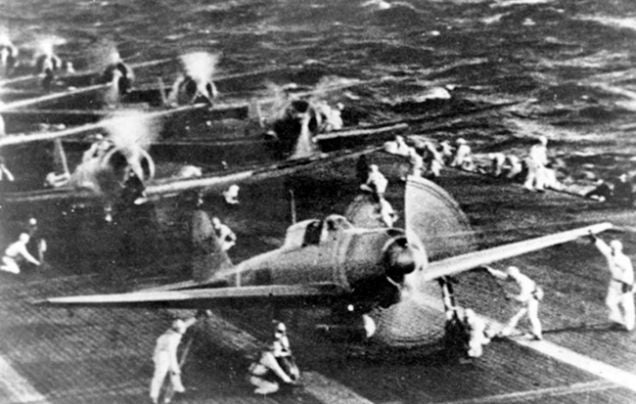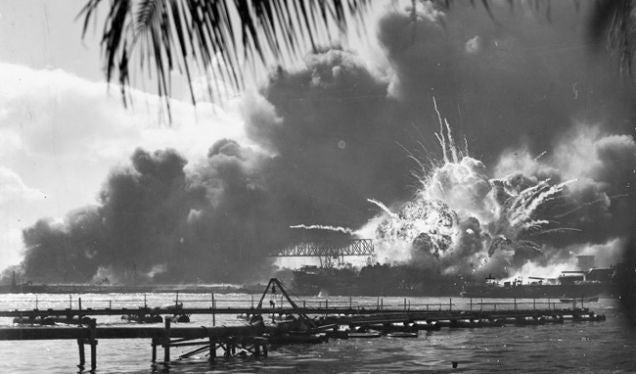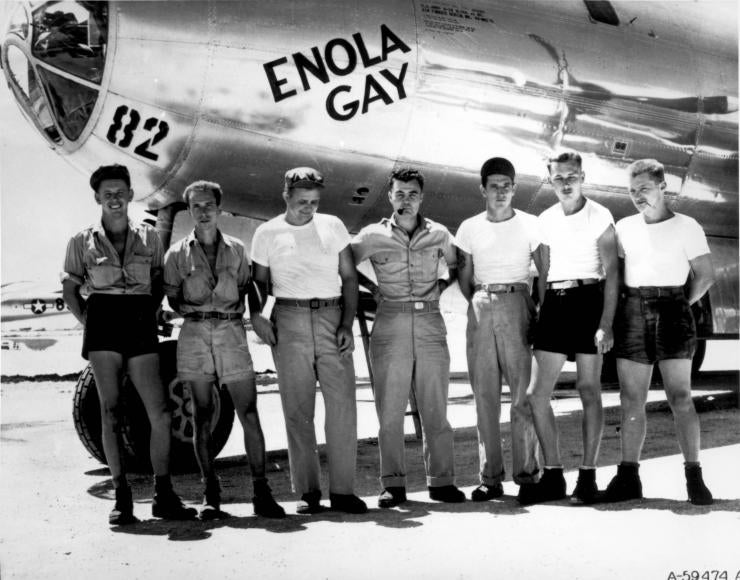 "ttyymmnn" (ttyymmnn)
"ttyymmnn" (ttyymmnn)
12/07/2016 at 11:35 • Filed to: planelopnik, planelopnik history
 10
10
 6
6
 "ttyymmnn" (ttyymmnn)
"ttyymmnn" (ttyymmnn)
12/07/2016 at 11:35 • Filed to: planelopnik, planelopnik history |  10 10
|  6 6 |

December 7, 1941 – Japan launches a sneak attack on US military bases at Pearl Harbor, Hawaii. When Commodore !!!error: Indecipherable SUB-paragraph formatting!!! arrived in Japan on July 8, 1853 (under orders to force the opening of Japanese ports to American trade, it should be noted), he found a closed society that was entirely self sufficient. However, following contact with the outside world, and the !!!error: Indecipherable SUB-paragraph formatting!!! , Japan quickly became an industrialized nation, and, as such, she increasingly needed more natural resources to keep her factories working. By the 1870s, Japan was already stretching its tentacles outward with eyes on resources they did not possess, such as coal, oil, steel, tin and rubber. In 1940, Japan’s stated goal became the creation of what they called the !!!error: Indecipherable SUB-paragraph formatting!!! , which was really nothing more than a grandiose name for a hoped-for Japanese empire that would encompass most of the western Pacific, a large part of eastern China, southeast Asia, and as far south as New Guinea. Essentially, their goals were identical to those of Germany, in that they wanted to create their own !!!error: Indecipherable SUB-paragraph formatting!!! in the Pacific. In 1937, Japan invaded China, starting the !!!error: Indecipherable SUB-paragraph formatting!!! , but found itself bogged down by 1940. In order to continue their offensive, the Japanese would need to sever the supply lines coming into China from the South. This meant that the Philippines, Guam and Wake Island would have to be taken, as well as the British Imperial possessions of Malaya, Singapore and Hong Kong. But, to be successful in this operation, they would need to neutralize the American fleet in Hawaii. While many believe that the Japanese attack was entirely unprovoked, the US had actually provided Japan with a casus belli . Since 1939, America had been engaged in an !!!error: Indecipherable SUB-paragraph formatting!!! with Japan as a result of Japanese military actions in Indochina, and some believe that President !!!error: Indecipherable SUB-paragraph formatting!!! was looking for an excuse to go to war in Europe, and Germany and Japan were allies at the time. However, the majority of America was mostly non-interventionist at that time. The Japanese attack on Pearl Harbor changed all that, and gave Roosevelt the justification he needed to take America into the Second World War. Some even suggest that Roosevelt had prior knowledge of the attack, but allowed it to happen anyway.

Japanese planes prepare to takeoff from the carrier Shokaku
On November 26, the Japanese fleet, which included the six aircraft carriers !!!error: Indecipherable SUB-paragraph formatting!!! , !!!error: Indecipherable SUB-paragraph formatting!!! , !!!error: Indecipherable SUB-paragraph formatting!!! , !!!error: Indecipherable SUB-paragraph formatting!!! , !!!error: Indecipherable SUB-paragraph formatting!!! , and !!!error: Indecipherable SUB-paragraph formatting!!! , stood out from northern Japan and steamed towards Hawaii. Arriving north of the islands on December 6, they prepared for the attack, completely undetected by the Americans. Early on the morning of December 7, 1941, two successive waves of Japanese !!!error: Indecipherable SUB-paragraph formatting!!! , !!!error: Indecipherable SUB-paragraph formatting!!! dive bombers and !!!error: Indecipherable SUB-paragraph formatting!!! torpedo bombers launched from the carriers. The first wave of 180 aircraft approached Oahu from the northwest, where they were detected by American radar installations. However, the radar operators believed that they were seeing a formation of !!!error: Indecipherable SUB-paragraph formatting!!! bombers that was scheduled to arrive that morning from California. The Japanese attackers found Pearl Harbor completely open to attack, with ships moored side by side and defensive emplacements unmanned. Commencing their attack at 7:48 am local time, the slower torpedo bombers led the way, since they would be most vulnerable once the Americans started shooting back. They headed straight for !!!error: Indecipherable SUB-paragraph formatting!!! , while the dive bombers attacked ships and other targets in Oahu, including !!!error: Indecipherable SUB-paragraph formatting!!! and !!!error: Indecipherable SUB-paragraph formatting!!! . The second wave, arriving at 8:54 am and made up of 171 aircraft, attacked simultaneously from three separate directions. Of the eight US battleships moored in Pearl Harbor, all were damaged and four were sunk. The attacks also sank or damaged three cruisers, three destroyers, an anti-aircraft training ship and a minelaying ship. The attacks on the airfields destroyed 188 aircraft, including four of the twelve B-17s that arrived from the US while the attack was underway. In all, 2,403 Americans were killed, over half perishing in the !!!error: Indecipherable SUB-paragraph formatting!!! when a bomb penetrated her deck and detonated the forward magazine. Against the American casualties, the Japanese lost 55 airmen, along with nine crewmen from six midget submarines that also took part in the attack. A third wave, which could have done crippling damage to American oil and port facilities, was not carried out.

The destroyer USS Shaw explodes as two bombs penetrate her forward magazine
The Japanese attack on Pearl Harbor and the island of Oahu ranks as one of the most audacious in military history. For the navies of the world, it demonstrated that the aircraft carrier, not the battleship, was now the most potent capital ship in the modern fleet. And though the attack was judged a tactical success, it ultimately turned out to be a serious strategic blunder for the Japanese. While the Japanese goal of keeping the Americans from interfering with their immediate plans in the Pacific was successful, the attack fell short of its aim of destroying the American Pacific fleet and putting the strategic harbor out of action. Key port facilities and oil installations were not destroyed, or were quickly repaired, meaning that Oahu never stopped functioning as a forward naval base as the Japanese hoped. Due to the shallow draft of the harbor, all the battleships but the Arizona were raised following the attack, and six of the ships were repaired and returned to fight later in the war. The loss of older battleships also hastened the modernization of the American fleet. But, most importantly, the three American aircraft carriers stationed in the Pacific—the !!!error: Indecipherable SUB-paragraph formatting!!! !!!error: Indecipherable SUB-paragraph formatting!!! , !!!error: Indecipherable SUB-paragraph formatting!!! , and !!!error: Indecipherable SUB-paragraph formatting!!! —were out to sea on December 7 and escaped the attack. Had they been sunk or seriously damaged, it would likely have set back American efforts in the Pacific for a year or more.

Destroyed American aircraft at Wheeler Army Airfield
Though some Japanese military commanders advocated for the invasion and occupation of Hawaii, the nation’s leaders decided against it. They believed that simply destroying America’s ability to use Pearl Harbor as a base was enough, and they consider Hawaii as a place from which to launch further attacks against the US mainland. However, they failed to appreciate the importance of Hawaii as a base from which the Americans might launch attacks against Japan. Rather than occupy Hawaii, the Japanese hoped to win a quick, decisive victory in the western Pacific while America licked its wounds, gaining territory that could then be defended while eventually wearing down their enemies and finally negotiating treaties to maintain their conquered possessions. But that was not to be. By awakening the military and industrial might of the US and its allies, the Japanese sowed the seeds for their ultimate defeat. Commander-in-Chief of the Imperial Japanese Navy Admiral !!!error: Indecipherable SUB-paragraph formatting!!! famously said,
In the first six to twelve months of a war with the United States and Great Britain I will run wild and win victory upon victory. But then, if the war continues after that, I have no expectation of success.
These would turn out to be prophetic words. Just six months after the attacks on Pearl Harbor, the American Navy decisively defeated the Japanese in the !!!error: Indecipherable SUB-paragraph formatting!!! , an American victory that, like the attack on Pearl Harbor, was fought entirely by aircraft. Though the US lost the Yorktown , the Japanese carrier force was decimated, as four of the six carriers that had taken part at Pearl Harbor were sent to the bottom of the Pacific by American dive bombers. In a fitting footnote to the attack on Pearl Harbor, the Battle of Midway, which swung the course of the war decidedly in America’s favor, was won by aircraft from the very American carriers that escaped the Japanese bombs and torpedoes on December 7, 1941. (Top image by unidentified Japanese pilot; others via US Navy)
!!! UNKNOWN CONTENT TYPE !!!
If you enjoy these Aviation History posts, please let me know in the comments. And if you missed any of the past articles, you can find them all at
!!!error: Indecipherable SUB-paragraph formatting!!!
.
!!! UNKNOWN CONTENT TYPE !!!
 Wheelerguy
> ttyymmnn
Wheelerguy
> ttyymmnn
12/07/2016 at 13:06 |
|
This kind of assault wouldn’t even be an option today.
Oh, right, Desert Storm.
EDIT: They’re two completely different things. Shit.
 OPPOsaurus WRX
> ttyymmnn
OPPOsaurus WRX
> ttyymmnn
12/07/2016 at 15:34 |
|
How much evidrnce is there for the Prez knowing about the attack before? I never heard that before
 ttyymmnn
> OPPOsaurus WRX
ttyymmnn
> OPPOsaurus WRX
12/07/2016 at 15:46 |
|
I have never dug into the actual evidence, but there are loads of conspiracy theories about it, and though it is considered a fringe theory, I think it is entirely plausible.
https://en.wikipedia.org/wiki/Pearl_Harbor_advance-knowledge_conspiracy_theory
But, even if FDR had not known explicitly that the Japanese would attack, the economic sanctions placed on Japan by the US and her European allies had so thoroughly backed Japan into a corner that war against the US and Europe was their only real option. There is no debate that FDR wanted to join the war to save both Britain and China. All he needed as an iron-clad justification, and the Japanese handed him one. So, while he may have lacked specifics, he may also have realized that it was just a matter of time until the Japanese did attack, and all he really had to do was sit back and do nothing.
 nermal
> ttyymmnn
nermal
> ttyymmnn
12/07/2016 at 17:14 |
|
The lesson we can take away from this event in hindsight is the importance of considering the consequences of your actions, both short and long term.
You could trigger a plane full of men in short shorts to pay you a visit in a few years, for instance.

 gmporschenut also a fan of hondas
> ttyymmnn
gmporschenut also a fan of hondas
> ttyymmnn
12/07/2016 at 20:09 |
|
https://www.amazon.com/China-Mirage-History-American-Disaster/dp/0316196681
Did you know the embargo was started by a few pro-china bureaucrats for 2 months after they refused to authorize the sale, before Roosevelt knew about it? in 1941 assets to purchase oil were frozen but Japan was able to continue to buy (non aviation gas) buy being granted licenses.. Thus they could publicly say there was an embargo on the war mongering Japanese, while making boatloads (literally) of money selling oil to Japan.
It was while Roosevelt was away for August that a couple bureaucrats thought “if there is an embargo why are we allowing this sale?” So they stopped the license, which left Japanese tankers sitting in LA and San Diago waiting for oil. By the time Roosevelt learned, the ships had left, Japan was super pissed and didn’t want to look weak.
http://www.salon.com/2013/12/05/oil_led_to_pearl_harbor/
A tactic Roosevelt often used was to have 2 groups or departments have overlapping responsibilities, knowing that they would have to go up the chain of command to resolve an issue. This way Roosevelt would be able to have 2 positions, yet be able to make the final decision and if one fucked up, had a department with rules to blame. Ingenious in a way, but also deadly.
 ttyymmnn
> gmporschenut also a fan of hondas
ttyymmnn
> gmporschenut also a fan of hondas
12/07/2016 at 21:59 |
|
Interesting reads, and a lot more detail than I had read before. The Salon article doesn’t say much about what FDR knew, and whether or not there is any merit to the theories that FDR let the Japanese attack. Could American officials really be that arrogant to think that Japan, already at war, wouldn’t attack the US to get what they needed? It’s hard to believe that Japan thought that war with the US would be winnable, if that was their aim. Pretty fascinating stuff, really. And lessons still to be learned.
Thanks for the links.